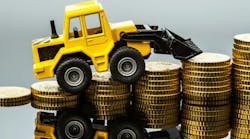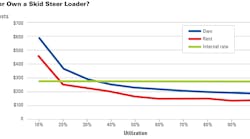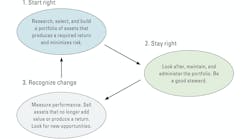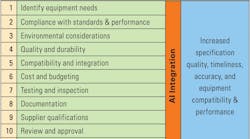We've all heard various "Rules of Thumb." These are little one liners that intuitively sum up whole textbooks of knowledge. Below are several equipment-related rules of thumb worth passing on along with some comments:
When the total of the equipment repair costs equal the purchase price, it's time to sell the machine.
My experience is that this is remarkably accurate. It's certainly not scientific because it doesn't address many important factors such as whether machines are front-line units or backups. It fails the test when machines are in severe-use service, say a soil stabilizer, or in light-duty applications, such as a pneumatic roller. But it's pretty close for rank-and-file earthmovers if, and it's a big if, you normally keep the machine for its full life cycle. It generally works for crawler tractors, wheel loaders, excavators and asphalt pavers.
Over a typical equipment lifetime, repair totals will be roughly 67 percent parts and 33 percent labor.
Yes, this works more often than not. Of course, equipment manufacturers have begun designing whole components for replacement rather than rebuild so that pushes up the parts costs. And if you're in Waycross, Georgia, your labor will be less than if you are in New York City.
Also, all manufacturers don't price their parts equally. There are huge price differences in equivalent parts even among the big four OEMs. They all say they research the prices of their competitors and make sure they're about the same—but that's not true. I'm also a big believer in the use of non-OEM parts (some call them "will fits") for parts that are not inside a case or housing.
Despite all these factors, the 67-33 split generally holds true for common machines.
Refurbishments and whole machine rebuilds add a new half life to the machine.
From my experience, this one varies a lot depending on the quality and depth of the refurb. Usually, refurbs tend to rebuild working components such as final drives, differentials, transmissions, engines, and obvious wear joints. But there are lots of moving parts and electrical parts that don't get replaced.
There is also a mathematical reliability factor. If you rebuild one component so that it has a reliability of 90 percent, that sounds pretty good. If you add the effect of five additional rebuilds, each with 90 percent reliability, the total machine reliability drops to 53 percent (0.9 x 0.9 x 0.9 x 0.9 x 0.9 x 0.9 = 0.53).
Standardization saves 10 percent in overall costs.
This has to be way low. I read a study done years ago by the U.S. military concluding that reasonable standardization saved at least 10 percent. My intuition is that it is closer to 25 percent when everything is considered. That would include better acquisition pricing, lower repairs due to the learning curve, lower parts and support inventories, and definitely better user practices.
$1 invested in preventive maintenance (PM) saves $8 in future repairs.
This is my favorite one of them all. Quite honestly, I don't know if it's exactly true, but my guess is that it's low. If an equipment owner did very little PM, his repairs and downtime would be astronomical and would cost him much more than the 8:1 ratio. If he already does a lot of PM, then another buck may not save the full $8. The ratio, though, is very much in favor of doing good preventive maintenance to save repairs and unplanned downtime.
So track your repair costs, pay attention to your parts costs, refurb only when it makes sense, standardize your fleet, and do PM like crazy. Not a bad recipe for success. Think about it.





